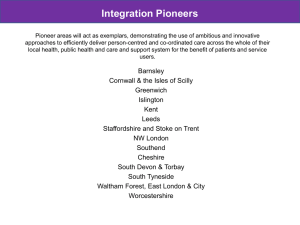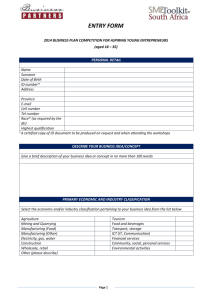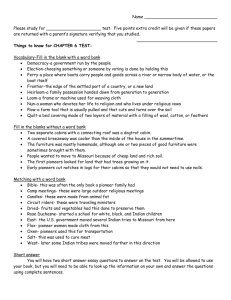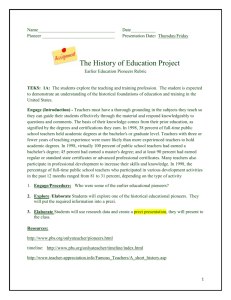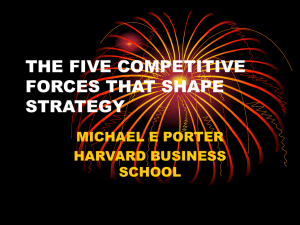Market Entry Strategies - Wright State University
advertisement
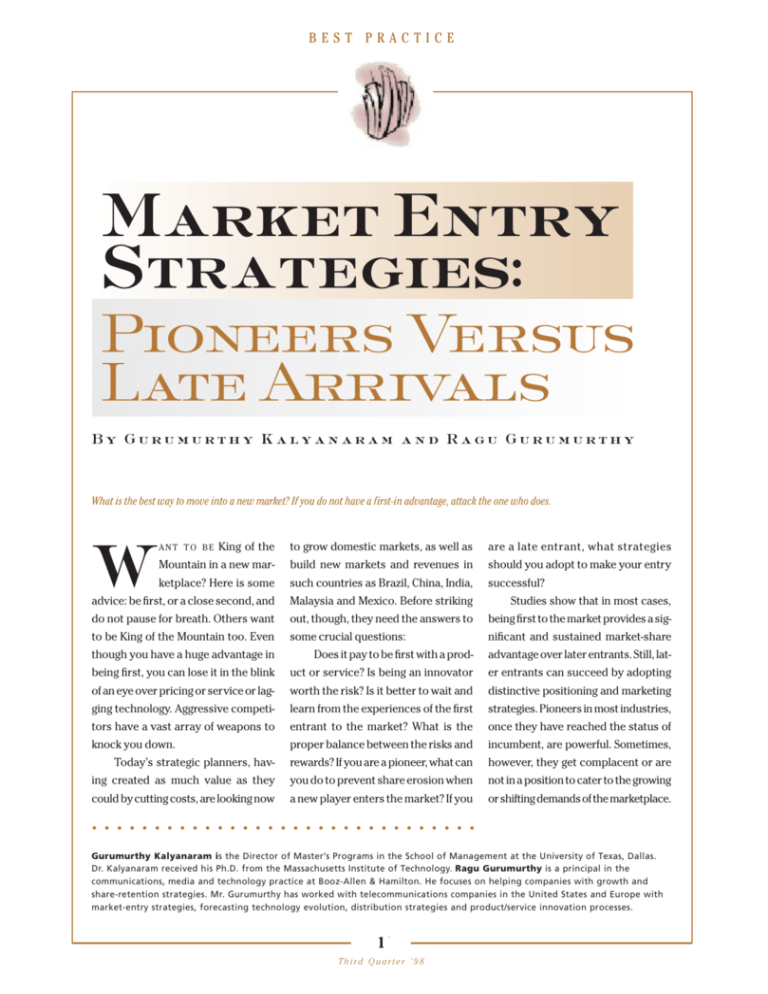
BEST PRACTICE Market Entry Strategies: Pioneers Versus Late Arrivals By Gurumurthy Kalyanaram and Ragu Gurumurthy What is the best way to move into a new market? If you do not have a first-in advantage, attack the one who does. King of the to grow domestic markets, as well as are a late entrant, what strategies Mountain in a new mar- build new markets and revenues in should you adopt to make your entry successful? ANT TO BE W ketplace? Here is some such countries as Brazil, China, India, advice: be first, or a close second, and Malaysia and Mexico. Before striking Studies show that in most cases, do not pause for breath. Others want out, though, they need the answers to being first to the market provides a sig- to be King of the Mountain too. Even some crucial questions: nificant and sustained market-share though you have a huge advantage in Does it pay to be first with a prod- advantage over later entrants. Still, lat- being first, you can lose it in the blink uct or service? Is being an innovator er entrants can succeed by adopting of an eye over pricing or service or lag- worth the risk? Is it better to wait and distinctive positioning and marketing ging technology. Aggressive competi- learn from the experiences of the first strategies. Pioneers in most industries, tors have a vast array of weapons to entrant to the market? What is the once they have reached the status of knock you down. proper balance between the risks and incumbent, are powerful. Sometimes, Today’s strategic planners, hav- rewards? If you are a pioneer, what can however, they get complacent or are ing created as much value as they you do to prevent share erosion when not in a position to cater to the growing could by cutting costs, are looking now a new player enters the market? If you or shifting demands of the marketplace. ............................... Gurumurthy Kalyanaram is the Director of Master’s Programs in the School of Management at the University of Texas, Dallas. Dr. Kalyanaram received his Ph.D. from the Massachusetts Institute of Technology. Ragu Gurumurthy is a principal in the communications, media and technology practice at Booz-Allen & Hamilton. He focuses on helping companies with growth and share-retention strategies. Mr. Gurumurthy has worked with telecommunications companies in the United States and Europe with market-entry strategies, forecasting technology evolution, distribution strategies and product/service innovation processes. 11 Third Q I sus au ret e1r2 ’ 9 8 BEST PRACTICE New entrants can take advantage of ➢ Improve a product or service, sights on China. Many heavy equip- gaps in the offerings of these aging pio- with focus on a niche market. Compa- ment manufacturers are targeting new- neers, or find innovative ways to mar- nies can compete by being innovative ly emerging markets that will need trac- ket their product or service. in the marketplace. The innovation tors and cranes for building. Faced with Pioneers with a distinctive pres- may be radical or incremental. One ex- intense competition and maturation in ence in the marketplace need to be in a ample of incremental innovation is an the local markets in the United States, position to react, or even better, antic- enhanced version of an existing prod- regional Bell operating companies such ipate potential entrants and increase uct. The enhanced product the barriers to their entry. For example, can compete directly with ex- Pioneers with a a pioneer may be in a position to re- isting products, or it can be distinctive presence in duce its price and decrease the value positioned to attract a small- of the business for a new entrant, or it er segment of the existing can block entrance entirely by control- market. In addition, the im- to be in a position to ling key distribution channels. proved product or service react, or even better, the marketplace need Whether a late entrant or a pio- can sometimes attract new anticipate potential neer seeking to foil newcomers, it customers that are not the entrants and increase helps to have a thorough understand- current target for the exist- the barriers to their ing of the entry and defensive strate- ing product or service. For entry. For example, gies available, a good sense of timing example: potential satel- and a game plan for decision-making. lite-based wireless service a pioneer may be in a providers are currently offer- position to reduce its BASIC STRATEGIC PLANNING ing a new feature called glob- price and decrease the Competitive strategies typically de- al coverage. This service value of the business pend on the market environment and could both complement and for a new entrant. the positioning and product portfolio replace options available to of the existing players. These are the current customers –– but basics: most of the potential players in the as BellSouth are expanding into emerg- ➢ Reduce price to penetrate an marketplace are targeting either trav- ing markets such as Brazil. existing market. By introducing a eling professionals who need to be in ➢ Develop new channels of distri- product at a lower price than the pio- constant touch or the rural market, in bution to access new markets or better neer’s, a latecomer can attract new which the cost-to-provision telecom- penetrate existing ones. Going global is customers who would not have oth- munications infrastructure is very high not the only solution. Sometimes the erwise purchased such a product –– and satellite-based options help gov- risk and the investment required to in effect expanding the total market. ernments offer ubiquitous telecommu- penetrate international markets may Reduced price can also induce the pi- nications services. In both cases the not be worth the return. Focusing on oneer’s current customers to switch. telecommunications market is ex- existing markets, where your company Still, this strategy is likely to result in panded, generating additional revenue. has a good understanding of the envi- reduced margins for the new entrant ➢ Target new geographic markets ronment, can prove less risky and bring compared with other players in the for existing products. As markets ma- quicker successes. This can be accom- market, unless the new entrant’s cost ture in the home base, companies tra- plished by repositioning the product or of production is relatively cheaper. ditionally look outside to more lucrative service through marketing, advertis- This can be adopted by both the in- markets. Most consumer goods com- ing, packaging and so on. For instance, cumbents and pioneers. panies, for instance, are setting their Dell Computer went after the mass 22 Third Q I sus au ret e1r2 ’ 9 8 BEST PRACTICE market by having customers place FICTION OR REALITY? 60 percent of their revenues from prod- their orders directly with Dell by Put simply, it costs the most to be the ucts introduced over the most recent phone, fax or computer. This direct first, for two reasons: three-year period. Obviously, these channel revolutionized the method 1) the product innovation re- of selling computers to the end users, quires a higher investment in research including corporate clients. and development than does product In addition to choosing the ap- imitation, and companies have succeeded in pioneering at a very high level. Does this occur in other industries and in countries other than the United propriate marketing strategy, it is cru- 2) the necessary marketplace ed- States? In fact, numerous studies have cial to determine the timing of the in- ucation and testing forces the pioneer found that later entrants in a market troduction of any new product. This is to spend heavily on advertising and achieve a lower market share than ear- especially true in high-tech industries, promotion. A second entrant enjoys lier entrants –– and that this holds true in which product life cycles are short the fruits of the pioneer’s labor. in a variety of product categories and and it is difficult for late entrants to Are there higher returns on mar- industries, such as consumer pack- catch up and extract reasonable re- ket share and investments to offset the aged goods, industrial goods and phar- turns. In most cases, if you are enter- pioneer’s increased costs and rela- maceuticals. Even when a company’s ing second or later in such a market, tively higher risks? Companies such as tangible (e.g., financial) and intangible you should do so immediately after the Hewlett-Packard Company and the (e.g., brand equity) resources and the pioneer. 3M Company, which generate growth business skills are considered, early through innovation, garner more than entrants continue to hold market- PIONEERING ADVANTAGE: ............................... EXHIBIT II ORDER OF MARKET ENTRY AND ACCOUNTING PROFIT EXHIBIT I FORECASTED MARKET SHARE RELATIVE TO THE PIONEERING BRAND Entry Urban et al. Kalyanaram and Berndt et al. Urban (1992) (1994) Order (1986) % % % 1.00 First Second Third Fourth Fifth Sixth 0.71 0.58 0.51 0.45 0.41 1.00 0.76 0.64 0.57 0.53 0.49 Consumer Goods Business 1.00 0.70 0.57 Return on Investment (%) Market Pioneers 25 Early followers 19 Late entrants 16 Industrial Goods Business Return on Investment (%) 0.49 0.44 0.40 Source: Adapted from Kalyanaram et al., “Order of Market Entry: Established Empirical Generalizations, Emerging Empirical Generalizations, and Future Research” Market Pioneers 24 Early followers 19 Late entrants 15 Source: Adapted from Lambbkin, M.B. (1988), “Order of Entry and Performance in New Markets” 33 Third Q I sus au ret e1r2 ’ 9 8 BEST PRACTICE share advantage. share of the first entrant in Belgium, think of photocopying for example, What is the magnitude of market- France, Germany, Italy, the Nether- Xerox is the name that jumps to mind. share penalty for later entrants? A lands and Spain is 58.5 percent and Third, consumers learn best the at- 1995 study by Gurumurthy Kalya- the second entrant is 41.5 percent. tributes of early entrants. More knowl- naram and others in Marketing Sci- The figures are consistent with the re- edge translates into more strongly ence suggests that the new entrant’s sults in Exhibit I since the second en- held beliefs and great confidence in forecasted market share divided by trant has about 70 percent of the pio- choice. And lastly, early entrants are the first entrant’s market share equals, neer’s market share. (See Exhibit III.) able to secure the best positioning in very roughly, one divided by the Why do early entrants so fre- square root of order of entry of the quently enjoy a higher market share? Does the pioneering advantage new entrant. (See Exhibit I.) Therefore, First, consumers in general are risk manifest itself in return-on-investment if there are two players in the market, averse. If a product or service pro- metrics apart from market share? Yes, the first entrant will have a market vides enough satisfaction, consumers after substantial research and devel- share of 59 percent and the second do not want to risk switching to a new opment investments, being early in the entrant will have a market share of 41 product. Second, the pioneer be- market is rewarding. Research shows percent (which is 70 percent of 59 comes the prototype for the product that the pioneers enjoy a higher return percent). This is validated in the cel- category. Later entrants are compared on investment in both consumer and lular industry in several countries in to the pioneer, and always somewhat industrial goods. (See Exhibit II.) This Europe in which the average market unfavorably. Whenever consumers research and development investment the marketplace. ............................... EXHIBIT III WESTERN EUROPE: ANNUAL NET ADDITION MARKET SHARE — 1996 Country Operator Order of Entry Date of Entry Net Annual Market Share Belgium Belgacom Mobile 1 January 1994 80% Belgium Mobistar 2 August 1996 40% France France Telecom 1 July 1992 55% France SFR 2 December 1992 45% Germany Mannesmann 1 June 1992 52% Germany T Mobil 2 June 1992 48% Italy Telecom Italia Mobile 1 October 1992 68% Italy Omnitel Pronto Italia 2 October 1992 32% Netherlands PTT Telecom 1 July 1994 55% Netherlands Libertel 2 September 1995 45% Spain Telefónica Moviles 1 July 1995 61% Spain Airtel 2 September 1995 39% Britain Vodafone 1 July 1992 42% Britain Cellnet 2 January 1994 31% Britain-DCS1800 One-2-One 3 September 1993 7% Britain-DCS1801 Orange 4 April 1994 European Average* } } First Entrant: Second Entrant: 58.5% 41.5% *Minus Britain 20% Source: Global Mobile, May 1997; Booz-Allen & Hamilton analysis 4 Third Quarter ’98 BEST PRACTICE and continuous new product launch is through another learning curve, when AGILITY NEEDED also used as an entry barrier by sever- there is already a robust supplier of FOR LATE ENTRANTS al pioneers. service. Another frequent constraint The picture, however, is not always so is access to property to build the rosy for pioneers and bleak for late en- A recent analysis of the evolution towers, since the first en- trants. In some industries and some When consumer learning trants have already seized geographic areas, pioneers have lost is limited, the pioneering the ideal sites for cover- market-share advantage relatively advantage is likewise age. This, in turn, may re- quickly. This can happen for any of bound to be limited. quire the later entrant to in- several reasons: Consumer learning vest larger amounts in 1) An entrenched pioneer may network infrastructure to not be offering a superior level of cus- gain similar coverage. tomer service. becomes very difficult if the product becomes Given these hurdles, it can 2) A new technology may have complex and technical. take two to three years be- changed the cost equation, so that a For example, when picture fore a challenger achieves new entrant can offer similar or better phones were introduced coverage competitive with service at a lower cost. in the late 1970’s, the the incumbent’s. veloped a new way to access the mar- and related quality of ser- ket, with an innovative distribution vice, another huge barrier strategy. market did not respond because consumers could 3) The new entrant may have de- In addition to coverage not find occasions to use to entry for new entrants is 4) The latecomer may simply be the product. the issue of number porta- pricing aggressively, targeting select- bility. Customers would ed segments by taking advantage of of wireless markets in Europe indi- have to get a new cellular number the incumbent’s tendency to average cates that first entrants are also mar- when they switch carriers since they pricing across all segments. ket leaders in most countries. (See Ex- cannot take the same phone number In what situations is the pioneer- hibit III.) Pioneers in cellular service with them as is done in land line net- ing market-share advantage muted? establish a presence in the market- works. In general customers do not For a start, when consumer learning is place, build brand equity and create like to change their phone number, es- limited, the pioneering advantage is an excellent distribution network. Al- pecially in Europe, where customers likewise bound to be limited. Con- so, a peculiarity of this industry is that receive calls in their mobile phones. sumer learning becomes very difficult the quality of service is primarily de- Thus, we see the inherent advantages if the product becomes complex and termined by coverage. Having evolved to being first in the market in the wire- technical. For example, when picture over time, the first entrant’s network less industry: control of ideal sites; phones were introduced in the late usually has much better coverage. freedom to evolve and fine-tune net- 1970’s, the market did not respond be- The customers become used to en- work coverage; building of brand loy- cause consumers could not find occa- hanced coverage over time. So new alty by offering superior customer sions to use the product. entrants have to invest significantly to service; locking in customers by sub- The pioneering advantage is also achieve this same coverage — an ef- sidizing equipment for an extended limited in a cluttered market: If there fort that is capital intensive and time period under fixed-service contracts, are many available brands, consumers consuming. All new networks have ini- and gaining control of key channels of react by becoming confused. tial bugs that take time to fix. Sub- distribution. Moving beyond such issues, what scribers are just not willing to go can later entrants do to overcome any 55 Third Q I sus au ret e1r2 ’ 9 8 BEST PRACTICE inherent market-share disadvantage? for the early entrants comes from high- lar to One-2-One’s. Orange, however, First, the later entrant should differen- er trial penetration. If the later entrant has followed a very aggressive entry tiate itself substantially in the minds of can generate greater trial market share, strategy. It has not only invested heav- the consumers. Such positioning can then its disadvantage can be over- ily in the network over the first two be accomplished through substantial come. Sample-product trial is an ap- years of introduction, but also devel- propriate mechanism. For exam- oped aggressive pricing strategies. Or- Later entrants can ple, goods, ange seized a third of Britain’s total position themselves as consumers can be supplied with market’s first quarter 1996 growth by variety enhancers, a sample product for trial. In non- offering about a 30 percent savings to rather than as consumer goods, other creative end users, compared with Vodafone replacements or mechanisms must be designed. and Cellnet. The pricing strategy was Limited demonstration of usage effective enough to compensate for Or- substitutes for the in consumer or prototypes is possible in soft- ange’s relatively poor network cover- pioneers. An example is ware products, and test usage is age. (This rapid increase in penetra- Orange, the late-entry possible in automobiles. Also, tion of new subscribers decreased in cellular service distributing the product through the second quarter, after Vodafone and provider in Britain, new channels such as direct mar- Cellnet lowered the price differentials which successfully keting (think of the Lands’ End in key segments.) Thus, aggressive nudged aside the catalogue or the Mary Kay cos- pricing tactics, investment in network metics parties) or a home-shop- infrastructure and innovative market- ping-network channel would ing tactics such as aggressive adver- place the product in the hands of tising and creative service bundling pioneers. changes in either the product or pro- more consumers. have made Orange a credible player. motion strategies. For example, the The later entrant can also seg- Different markets require different Chrysler Corporation redefined per- ment the market, focusing on a partic- strategies. What worked for Orange ceptions of its minivans by introducing ular target. By providing appropriate in Britain, for example, will not work Caravan, a two-door van. The Ford Cor- value, the later entrant can extract ad- for new entrants in Scandinavia. There, poration’s Windstar, expected to be a ditional rents. A good example of this the incumbent’s monopolies are not marquee van, substantially lost its is the competition among the Interna- driven by profits from the wireless in- glamour to the Caravan. When the Gen- tional Business Machines Corporation, dustries, and thus they price their wire- eral Motors Corporation decided to Compaq Computer and Dell Computer less services below the average price reposition its Oldsmobile, it changed in the personal-computer market. Fi- for the rest of Europe. This is a signifi- not only its product but also its adver- nally, later entrants can position them- cant barrier to entry for new players, tising copy. The new copy appealed to selves as variety enhancers, rather especially since entering the industry consumers over 30 years old, project- than as replacements or substitutes for requires a high capital investment. So ing the image of a younger profession- the pioneers. the key source of differentiation for al woman via this voice-over: “This car An example is Orange, the late-en- new entrants in such situations is go- is not only for your father’s generation, try cellular service provider in Britain, ing to be creative marketing, innovative but it’s for you too.” which successfully nudged aside the advertising, new service packages and A second route for later entrants pioneers. Orange entered the market superior customer service. This is is to discover creative ways to increase almost 30 months after the first en- especially true since the incumbents product trial. At best, one study has trant, Vodafone, and nine months after offer a relatively poor level of customer found that the market-share advantage One-2-One, and with technology simi- service, a concern to end users. 77 Third Q I sus au ret e1r2 ’ 9 8 BEST PRACTICE Later entrants can also succeed to the personal computer market, cap- is a low-cost industry and it will be dif- by attacking high-growth markets par- tured the lead in the 1980’s by develop- ficult for them to survive. Pricing below ticularly when there is a significant ing the technology and using its pow- variable cost, however, is illegal in most shift in the industry. Such shifts can be erful marketing engine. Later, Compaq countries. On the other hand, new en- due to changes in regulation, or tech- and Dell fundamentally redefined the trants traditionally focus on a few key nological breakthroughs that improve business. Compaq reduced the product, or breakthroughs that the cost by changing the Usually, however, improve the process of manufacturing manufacturing process and technological innovation and delivering the product. The clas- having superior logistics. gives a company an edge sic example is MCI’s success in pene- Dell, in addition to using an trating the long-distance market and efficient winning a regulatory battle with the process and superb logistics, incumbents catch on fairly AT&T Corporation. invented the mail-order or di- quickly. Given that this Another strategic option for the rect channel to access end is the case, new entrants later entrant is micro-segmenting the users, who by now were com- should support their customer base — that is, targeting fortable with personal com- innovations with effective high-value customers who are able puter technology. I.B.M. was positioning, appropriate and willing to pay a higher price for not able to react to these the product or service relative to the changes fast enough and lost cost incurred in catering to that seg- its lead in the 1990’s. manufacturing for only a time, since pricing and aggressive advertising. ment. For example, the competitiveaccess providers (now Competitive DEFENSE STRATEGIES segments of the market –– typically Local Exchange Carriers, or CLECS), FOR PIONEERS those that are subsidizing the cost to in order to provide local telecommu- Even as new entrants attempt to re- serve other segments of the incum- nications services, basically skimmed define the business or formulate niche bents. So, it is important for pioneers the best customers of the regional strategies to attack profitable indus- to understand their end-user segments Bell operating companies by offering tries and market segments, pioneers and to adopt a differential pricing a lower price. This was possible be- can fight back to retain their competi- scheme to extract optimal rent from cause the regional companies had tive advantage. The major strategies each of the segments. adopted an average price scheme for the pioneers: partly dictated by the Federal Communications Commission. Innovators have also been successful in entering markets with a significantly better technology. Usually, however, technological innovation Pioneers can also attempt to lock 1) increase the barriers to entry for later entrants, up the key channels of distribution, making it difficult for new entrants to get 2) innovate faster than the latecomers, and access to the market. In several industries and countries, however, it is not 3) build a market-responsive and flexible organization. possible to get exclusive distribution rights. Pioneers can also offer special gives a company an edge for only a In most markets both pioneers types of enhanced customer service time, since incumbents catch on fairly and later entrants operate with incom- packages or reward programs to make quickly. Given that this is the case, new plete information. Pioneers can take it harder for key customers to switch. entrants should support their innova- advantage of this by using effective sig- Another route, especially in the tions with effective positioning, appro- naling mechanisms as a deterrent. For high-tech industries, is for a pioneer priate pricing and aggressive advertis- example, pioneers can cut price, sig- to remain innovative and launch the ing. For example, I.B.M., a later entrant naling to potential new entrants that it next generation of products –– or at 88 Third Q I sus au ret e1r2 ’ 9 8 BEST PRACTICE least announce the next generation of ample, the Eastman Kodak Company’s services (P.C.S.) players among the products, thus deterring the entry of strategy was to attack Fuji in its home cellular customer base. But as these competition. The Intel Corporation’s market. This strategy met with mixed companies, which offer a service similar strategy in this regard is an example. results, due to the tight controls in the to cellular but based on a different tech- Japanese market. nology, build their networks and offer Finally, a responsive and flexible organization may be the most produc- The underlying parameters for all enhanced services, they will inevitably tive route, especially when the struc- these strategies are that companies begin to attract cellular customers un- ture of an industry changes drastically should be aware of the market dynam- less cellular companies can offer simi- ics and have an organization lar features in the long run. Meanwhile, Another route, that is flexible with the right cul- both the P.C.S. companies and the cel- especially in the high- ture to adapt, not only reacting lular tech industries, is for to potential competition but al- aggressive advertising campaigns. companies have launched so proactively developing their a pioneer to remain strategies. It is easier to lose a KEY SOURCES OF DIFFERENTIATION innovative and launch market-share point than it is to It is important to note that in the case of the next generation of gain one. the telecommunications industry, pio- An example of a good neering advantage can be sustained announce the next blocking strategy is Vodafone’s only through continuous investment in generation of products, decision to lower its prices in building network infrastructure and the thus deterring the key market segments to match offering of superior customer service –– those of its new competitor, the two key sources of differentiation. Orange, thereby reducing the In the wireless industry, customers are The Intel Corporation’s price differential between the repeat purchasers, since their contract strategy in this regard two companies. While doing terms typically last for only one year is an example. this, Vodafone kept its average and the cost of handsets is dropping price in the market constant rapidly. This situation could enable a or there is a seismic shift in the regula- and extracted more rent from cus- late entrant to compete effectively by tory environment. In the telecommu- tomers who were not targeted by the developing a good network infrastruc- nications industry, for instance, the competition. ture and by gaining access to good dis- products — or at least entry of competition. 1996 Telecommunications Act has fun- Managers should have a feel for the tribution networks. This is evident from damentally changed the rules of the marketplace, to correctly estimate the the fact that the incumbents in several game, leaving almost all the markets switching barriers for customers and countries have not been able to sustain open for competition. This has forced set the price differential accordingly. their lead and the differences between both the regional Bell operating com- Another example in the wireless early entrants and second entrants are panies and the long-distance carriers industry is the case of cellular compa- decreasing rapidly. For example, in such as AT&T and MCI to revise their nies in the United States. These com- Britain, Vodafone had an 18-month ad- strategies. Aging pioneers in other in- panies have undertaken a suite of coun- vantage over its prime competitor, Cell- dustries have also followed the strate- terattacks, including innovative service net, with similar technology. Three gy of attack as best defense, targeting packages and special deals on the equip- years after the launch of Cellnet, how- potential new entrants’ home bases — ment for one-year contracts, thereby in- ever, the difference in market share in be it geographic or product markets. creasing the switching barriers for the annual net additions between Voda- As Fuji penetrated the photographic customers. This has also slowed the fone and Cellnet is only 11 percent. film market in the United States, for ex- penetration of personal -communications- Vodafone has been able to retain its lead 99 Third Q I sus au ret e1r2 ’ 9 8 BEST PRACTICE in the recent past only by fighting back The first component in our frame- Several qualitative and quantita- efficiently on the customer-service di- work involves developing an under- tive tools are available to assist in mension and by developing creative ser- standing of the dynamics of the market. evaluating these critical issues. For vice-bundling strategies. The critical areas to be analyzed are: instance, the model developed by F.M. 1) those fundamental drivers of Bass, the Bass model (1969, 1987), and MARKETING-STRATEGY technology that may cause a signifi- the Booz-Allen & Hamilton model FRAMEWORK cant shift in the market; (1997) are highly useful for forecasting Having thoroughly analyzed the var- 2) changes in governance, such market size and growth. Competitive ious strategies adopted by success- as any shifts in regulatory policies that assessment on the other hand, is pri- ful pioneers and later entrants, we might have a marked impact on the in- marily done by conducting extensive have developed a framework both dustry structure; secondary research on the key players. can employ to formulate strategies for growth, penetration or share re- 3) the size and growth of the potential market, and tention, as the case may be. Our experience indicates that more than 60 percent of relevant information 4) the competitive profile. can be found in public sources and that ............................... EXHIBIT IV MARKETING-STRATEGY FRAMEWORK CAPABILITY ASSESSMENT AND OFFERING UNDERSTAND MARKET DYNAMICS Understand Industry Characteristic Understand Market Size and Growth Needs • Economics of scale • Current target and scope market • Technology drivers • Key segment trends characteristics • Effect of external • Domestic versus factors such as global market regulation and • Market’s implicit public policy and explicit needs Competitor’s Positioning; Strengths and Weaknesses • Products and services offered (including substitutes) • Key segments targeted • Pricing and positioning Market Access: Channel Options For Existing Markets • Availability of channels • Access to key segments Product/Service Offering • Features of new products • Service-evolution plans Non-Product Related Sources of Differentiation • Customer service • Necessary to access to key market segments Economic Assessment • Cost of manufacturing • Cost of bringing to market STRATEGY FORMULATION Develop Product Market Strategic Options • Develop strategic segmentation based on needs and new service offering • Positioning and targeting strategy • Pricing and promotion • Channel/market access Develop Core Benefit Proposition Assess Options and Select Optimal Option • Implementability risk • Economic assessment –cost –potential revenue • Value proposition of the offering to key segments • Branding strategy Source: Booz-Allen & Hamilton 10 10 Third Q I sus au ret e1r2 ’ 9 8 BEST PRACTICE the challenge lies in the gathering and entiation, such as customer service, available to facilitate scenario plan- synthesis of this information. innovative ways to access end-users, ning and decision making. These in- The second component of the creative marketing partnerships with clude the formulation suggested by framework involves conducting an in- other services such as frequent flyer Dr. Kalyanaram in the journal Market- ternal assessment of your company’s programs, and so on. ing Science (1995) and market share capabilities and product offerings. At the completion of external and models by Dr. Kalyanaram and Glen L. Product or service development is an internal assessment, a company is Urban (1992) and by Dr. Urban and iterative process between developers ready for the final component of the others (1986), again in Marketing Sci- and researchers, one involving mar- framework: the actual development of ence. Other useful approaches for ketplace feedback. Once a product is the product strategy. Strategic ele- product strategy are the lead-user defined and the positioning deter- ments here include segmentation, po- technology proposed by Eric Von mined, it is important to understand sitioning and decisions on marketing Hippel, and the “wargaming” simula- the economics of manufacturing. In a instruments. tion analysis methodology developed competitive environment in which a One of the most important strate- by Booz-Allen. Thus, based on the technology edge is short-lived, try to gic elements is the timing of product market, internal and product strate- think beyond simply making a good entry. Should the company be the first gic assessments, an optimal strategy product in an economical way. Com- to enter the market or a later entrant? can be formulated. panies need to evaluate and develop Just what are the risks and rewards? non-product-related sources of differ- Again, there are some important tools 11 Issue 12 Reprint No. 98307

